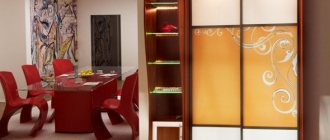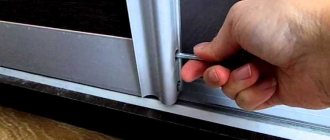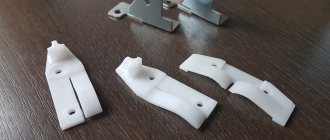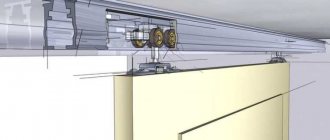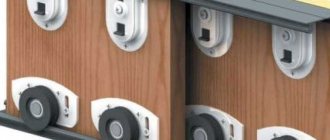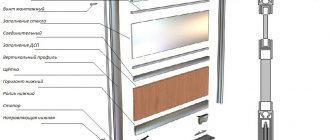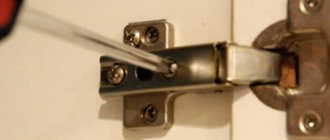Chipboard
This is the most cost-effective type of design for a compartment door, into the frame of which a chipboard panel 8-10 mm thick is inserted. The door can be mono-filled, i.e. using one sheet of panel for the entire height and width. This version of the sliding wardrobe looks strictly, without frills. The filling of the door can be divided into fragments of different sizes, colors, shapes and even materials. For example: combine chipboard with a mirror or glass.
The average cost of a compartment door made of chipboard is 4-5 thousand rubles.
Calculator (calculation program) for doors for sliding wardrobes
To get a comfortable and high-quality wardrobe, the easiest way is to turn to specialists for help. They will carry out the necessary calculations and assemble the furniture. But if you wish, you can cope with the task yourself and assemble the wardrobe doors yourself.
One of the main conditions for proper assembly is the correct calculation of components and parts for filling the facade. To cope with the task, you need to know the principles and secrets of calculating all elements. It is much easier for an amateur, as well as a professional in this field, to use the RIAL.PRO door calculator.
Calculator RIAL.PRO. Sketch of wardrobe doors
Calculator RIAL.PRO. Calculation of wardrobe doors
Calculator RIAL.PRO. Ordering wardrobe doors
Door calculator for sliding wardrobes
The program is a convenient free application that can be downloaded to your PC or laptop in the appropriate section.
Advantages of calculating a door system using a calculator:
- the program does not require an Internet connection;
- no special skills required;
- branded calculator contains all colors and types of profiles available in the RIAL.PRO warehouse;
- The program is updated when new systems appear in the range.
To use the program, just click the “Download” button and follow further instructions.
Mirror.
The mirror is quite often used in the facades of sliding wardrobes. The thickness of the mirror is 4 mm. The film on the reverse side of the mirror (amalgam) is also protective; from an accidental strong blow the mirror will not crumble, but only crack.
There are several types of mirrors used in wardrobes: regular, bronze and gray.
It is possible to apply sandblasting or stained glass patterns on mirrors.
The average cost of a mirror door is 5-6 thousand rubles.
Video instructions for assembly and installation
To easily and without difficulty install sliding furniture or a partition, just watch a video on assembling wardrobe doors. Depending on the type of system (top-hung, bottom-hung, non-threshold), doors can be installed:
- directly into the closet;
- into the doorway.
Calculation of the size of wardrobe doors of the Ramir and Universal systems
Assembly and installation of wardrobe doors of the Puerta system
Video instructions for assembling sliding wardrobes
Even more videos about step-by-step assembly and installation of various door systems are presented in the corresponding section.
For each individual case there is a specific video with instructions.
Before installing the system, it is extremely important to calculate the correct position of the doors. In the videos you will also find instructions for measuring openings and niches. Thanks to video instructions, you will cope with any task:
- taking measurements;
- door assembly;
- door installation.
The videos show in detail the options for fastening doors of various systems.
Decorative glass.
Decorative glass is a satin mirror with a matte pattern applied on a mirror background using chemical etching.
Sandblasting drawings.
Sandblasting of glass is a matte and rough-to-the-touch pattern that is applied with a jet of sand on a 4 mm thick mirror in a special chamber. There are a huge number of drawing templates.
There are several types of application of patterns: on the front side, on the reverse side, on the back side (according to the shape of the pattern, a stream of sand destroys the reflective film - amalgam), matte pattern on a mirror background, mirror pattern on a matte field (the field around the pattern is processed, the pattern itself remains untouched) , deep drawing (a relief is created on a mirror field), the use of paints when processing sand, the so-called matting.
.
The average cost of a door with a sandblasted pattern is 12-13 thousand rubles
Internal filling of the sash
The filling is the inside of the door, framed by a metal frame. Can be made of chipboard or plywood. The thickness of the selected material determines the thickness of the doors.
Filling options
Recommended width and height
The minimum permissible width of the door leaf should not be less than 50 cm. Reducing the size will lead to deterioration in functionality. The opening is accompanied by a tilt towards the applied effort. As a result, the lower profile will rub against the skids or jump out of them.
Example of a coupe design
The maximum width should not exceed 1-1.1 meters. Large sizes create inconvenience in use - the weight increases and the movement of such a structure becomes more difficult.
The dimensions of the profile handle allow us to produce coupes of various heights, because the manufacturer produces products with a length of 5.5 meters. The cutting of the material is already carried out at furniture factories.
overlap
When making calculations, take into account the fact that in the closed position the upper leaf should overlap the lower one by the width of the profile. Thus, if we consider the position of the compartment in section, it will be seen that the profile handles overlap each other.
overlap
Attention! The thickness of the schlegel is not taken into account.
The number of sashes to choose is determined by the dimensions of the opening. At the same time, it must be remembered that the doors should not block access to the filling of the cabinet.
For frameless canvases, average overlap values are taken. Usually they do not exceed 20-30 mm.
Examples of determining the width of doors
To determine the correct width, it is necessary to take into account the overlap of the sashes. That is, based on the number of sliding structures that can be accommodated, the width of one compartment door is determined by calculation.
Calculation methods
Measurements are made as follows:
- Determine the width of the profile handle.
- Add to the width of the opening niche.
- We divide the result by two.
- As a result, we get the width of one door.
A larger number of movable sashes increases overlaps. That is, each profile must overlap each other in a checkerboard pattern, overlapping the previous structure. From this it turns out that to the width of the opening, you need to add the number of overlaps and divide by the number of door leaves.
Let's look at a practical example of a two-door wardrobe:
- Profile handle width – 20 mm
- Opening – 1500 mm
- We calculate: 1500+20=1570:2
- As a result, we get 785 mm - this is the width of one door leaf
Three-door design:
- Opening – 1700 mm
- Profile handle – 20 mm
- 3 doors will mean that the number of overlaps is 2. It is necessary to find the total width of the door handles - 20x2 = 40 mm
- 1700+40=1740:3
- We get the result: 580 mm width of one blade.
Examples of determining door heights
In order to determine the height, there is no need to carry out many calculations, just perform a few steps. To get the correct figures, you need to subtract 40 mm from the opening height. These numbers are equal to the height of the upper section of the door of the sliding wardrobe installed in the track.
Let's look at the calculation using an example:
- Opening height 2400 mm
- 2400 subtract 40 mm
- As a result, we get 2360 mm. This is the height of the door leaf.
There are cases when craftsmen, saving free space or making mistakes in calculations, try to install sashes with a minimum gap of 30 mm. This is possible, but causes difficulties during installation. In addition, the door leaf installed in this way has a tight movement.
An example of calculating the filling dimensions of compartment doors
There should not be any difficulties with calculating the filling, since the process consists of simple actions that even a schoolchild can cope with.
The filling represents the internal contents of the metal frame framing the compartment. Accordingly, to determine these indicators, you need to find out the overall dimensions of the sashes and subtract the width of the profiles.
Filling
Steps to perform calculations:
- We measure the internal fullness of any metal handle. Indicators must be as accurate as possible. We multiply the result by 2. Example: 20x2=40 mm. We subtract the filling of the handles from the total width - 805-40. We get the width of the door filling - 755 mm.
- Next, we measure the upper and lower metal profiles. For example, the lower part is 14 mm, and the upper part is 45 mm. We add them together – 14+45=59 mm. Having measured the total height of the canvas, we find that it is 2500 mm. Then you need to subtract the height of the canvas from the height of the profile - 2500-59 = 2341 mm.
Measuring the lower and upper profile
If the sash is made of mirror or glass, then it is necessary to subtract the dimensions of the silicone seal from the overall dimensions. As a rule, the thickness of silicone does not exceed 1 mm. If we take into account that the seal is installed along the entire contour, then the width of the silicone must be multiplied by 2. Therefore, 2 mm is subtracted from the overall dimensions of the door leaf.
How to calculate the length of the upper and lower profile
Finally, the frame structure is calculated. The height of the profile handle coincides with the doors - 2360 mm. To correctly determine the length of the metal strips, you need to measure the profile up to the groove.
Assembly diagram
Let's do it with an example:
- Width – 20 mm
- We multiply by 2 because we have a pair of handles
- Subtract 40 mm from the total width of 580 mm
- We get the length of the lower and upper profile - 540 mm each

